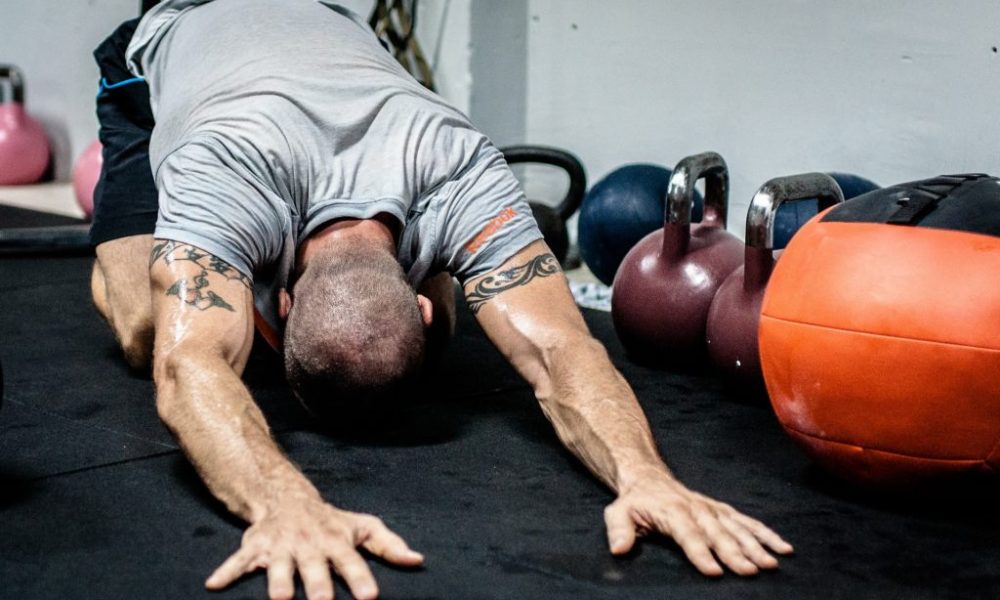
Training to Failure – Optimal or Overrated?
Training to Failure – Optimal or Overrated? The training to failure debate rages on as bros, lifting nerds, and coaches just can’t seem to agree

Stretching is the best thing you’re not doing for muscle growth. Yes you read that correctly. Stretching, the thing that annoying yoga girls won’t shut up about actually builds muscle.
Unfortunately, the way those yoga girls stretch is not the correct way if you want to maximize on muscle growth.
Just by looking at them, it’s pretty obvious that stretching for a full hour without lifting weights while humming namaste isn’t going to get you jacked.
So how should we stretch to enhance muscle hypertrophy?
I’ll get into all the specific details later, but first a quick history lesson.
Stretching for muscle growth is not a new thing. Many old school bodybuilders swore by it. Guys like Dante Trudel have used it for decades and have popularized it before many of us even started lifting.
The theory behind it is that once a muscle is filled with blood, lengthening it enhances it’s hypertrophic abilities. While research still isn’t clear on all the exact reasons behind why this could occur, the findings we have now are fairly promising as far as results are concerned.
After extensive reading combined with recent experiences testing this on my clients and myself, I’m fully hopping on the stretching for muscle growth bandwagon.
I think as more research comes out, this will be one of those things that everybody does to maximize muscle growth. If lots of future research confirms this as total bro-science, I don’t mind admitting I was wrong either.
But for now, let’s look at the current research we have and why I think stretching for muscle growth is a deeply viable strategy to add to your training.
This idea was first tested in animals, particularly birds.
The first study took quails and stretched one of their wings for a total of 5 days within a 15 day period (1). Sounds a bit barbaric, but hey, surprisingly muscle mass and muscle length increased significantly.
Score 1 for hypertrophic stretching.
The second study took even more quails cause you know, let’s just sacrifice more birds for the sake of science.
Anyways, this study stretched their wings progressively over the course of a month resulting in an astonishing 317% growth in muscle (2).
Finally, a 1995 study done in chickens showed an increase in muscle mass by 110% (3). While researchers at the time were unsure if this would translate into human practice, some of the early bodybuilders ran with this idea while many claimed it just wouldn’t work in humans.
With over 2 decades of research later, we can now see why stretching can be pretty useful for growing juicy slabs of muscle.
People think lifting weights and stretching are in 2 separate worlds, but they are actually quite similar. Let me explain.
You see, the main mechanism behind muscle growth is mechanical tension (4). Mechanical tension is basically the forces or tension placed on the muscle. These forces are sensed by mechanosensors which then trigger off a set of chemical responses based on how pronounced and how much mechanical tension occurred, which then results in muscle growth.
Most people know that mechanical tension occurs when force is actively produced by the muscle contracting, but most people don’t know mechanical tension also occurs passively when a muscle is stretched either by external load or just manually stretching.
This 2017 study showed the effects of that as stretch training increased muscle length, muscle size, and resulted in regional hypertrophy (6).
So while mechanical tension is the stimulus behind hypertrophy, it can be achieved actively by muscles producing force or passively by a muscle being stretched.
Both active and passive forces occur when you strength train as you lift and lower a weight under control.
Both active and passive forces also occur when you stretch like holding a static pose while squeezing the targeted muscle.
This is why picking up heavy stuff is more similar to stretching than most people think. Mechanical tension occurs with both of them, either actively, passively, or both.
Now that we know stretching can be anabolic, let’s breakdown how to do it.
There are 2 main ways to do this, during a lifting set where a muscle is overloaded and between sets where a muscle might not necessarily be loaded. Let’s start with the less controversial of the two which is stretching during the set.
The stretched position has been shown to be particularly anabolic (7,19,20). This 2014 study compared groups training between short muscle lengths and longer muscle lengths while equating the same range of motion and muscle force (8). The group that trained at longer muscle lengths (stretched position) built more muscle, gained more strength, and got a greater hormonal response.
This was followed by a 4 week detraining period in which measurements were taken again. Interestingly the group who trained in the stretched position also retained more strength as well.
So not only is the stretched position useful for racking up gains, but it’s also great at retaining your hard earned gains as well if you were to ever take a break from lifting for whatever reason.
The study could also explain why training in a full range of motion usually results in better muscle growth than a partial range of motion as doing a full range is more likely to take advantage of the useful stretched position.
So a good rule of thumb is to emphasize the stretched position in your workouts when you can. Some exercises are better than others when it comes to the stretched position, think incline curls over dumbbell curls.
Once you find the right exercises, here’s a few ways to do stretch emphasized training:
So the first way to stretch for muscle growth is simply emphasize the stretched position while lifting on key exercises.
An additional way you can stretch for muscle growth is to stretch between sets as part of your rest periods. This method is a bit more controversial, but I think the science is in favor of it.
One of the reasons it’s controversial is because you’re essentially doing stretches that aren’t loaded. The muscles don’t have any significant forces acting against it, so skeptics are quick to point out that the tension is not sufficient.
However, this just isn’t true. Even without overloading a muscle, active and passive static stretching has been shown to cause hypertrophy in humans (6,13).
This 2011 paper was one of the first to vouch for stretching between sets (14). The authors suspected because you can add more total time under tension by stretching between sets without increasing workout time while not hindering performance, you could achieve greater hypertrophy.
As time goes by, more specific evidence is presented.
This 2013 study showed the group who stretched between sets had greater flexibility and strength gains (15). The subjects held static stretches between sets for 30 seconds with an intensity level described as mild discomfort.
So now we know stretching between sets probably doesn’t hinder your strength performance if done within a reasonable amount of time and at the very least will boost your flexibility just in case you want to show off to a hot yoga chick.
But what about muscle growth? Are there any controlled studies showing stretching between sets actually makes your guns bigger?
Yes, there’s one, but unfortunately it’s not as clear cut as we’d like.
A 2019 study published in The Journal of Strength and Conditioning had 2 groups who performed the same training program (16). During rest periods, one group just rested while the other group stretched between sets for 30 seconds of their rest periods on the muscle they just trained.
Researchers measured both strength and hypertrophy. Strength was clearly similar between groups, but hypertrophy is a bit unclear.
Five markers of muscle growth were measured, the biceps, triceps, front of the quads, outer quads, and the sum total.
The biceps, triceps, and front of the quads showed no statistical difference between groups.
The outer quad did show to be statistically significantly bigger in the stretching group. This might lead people to think stretching between sets isn’t that useful for most muscles, but when researchers added the sum total of all 4 muscles measured, it also reached statistical significance favoring the stretching group by about 50%. All individual measures including strength comparisons favored the stretching group revealing an interesting trend.
So while only 2/5 markers of hypertrophy favored the stretching group, the overall results and raw data shows stretching between sets to be very promising.
A similar study was done in trained lifters showed no additional muscle growth (21). However, the stretch durations were short and intensity of stretches were weak.
This section will be where I update this article with new research. A new review came out showing a trend that the effects of stretch training may depend on the intensity (17). Painful weighted stretches may be necessary if non-weighted stretches are not intense enough.
Again, this makes sense mechanistically because these stretches are essentially an extra eccentric rep, albeit a deeply intense one.
Another newer study found in trained individual with 7.5 years of experience grew bigger hamstrings simply from adding a hamstring stretch prior to squatting (18). This shows trained trainees likely still have untapped muscle growth from deeper stretching.
It makes sense as isometric training the in the stretched position is more anabolic than isometric training in the shortened position (22).
With the last few weeks of experimenting with this on myself along with my clients, I am definitely in favor of stretching between sets as well as post exercise deep weighted stretching.
My mind-muscle connection has improved and muscle pumps feel epically better with no negative effects on performance.
I’ve also noticed my movement and flexibility are undoubtedly better along with receiving nothing but great feedback from clients.
Would you look at that? We’re at the end of the article.
Nunes, João Pedro, et al. “Does Stretch Training Induce Muscle Hypertrophy in Humans? A Review of the Literature.” Wiley Online Library, John Wiley & Sons, Ltd, 5 Feb. 2020, onlinelibrary.wiley.com/doi/abs/10.1111/cpf.12622.
Trindade, Thiago Barbosa, et al. “Pre-Stretching of the Hamstrings Before Squatting Acutely Increases Biceps Femoris Thickness Without Impairing Exercise Performance.” Frontiers in Physiology, Frontiers Media S.A., 7 July 2020, www.ncbi.nlm.nih.gov/pmc/articles/PMC7358463/.
Krüger, Martina, and Sebastian Kötter. “Titin, a Central Mediator for Hypertrophic Signaling, Exercise-Induced Mechanosignaling and Skeletal Muscle Remodeling.” Frontiers in Physiology, Frontiers Media S.A., 1 Mar. 2016, https://www.ncbi.nlm.nih.gov/pmc/articles/PMC4771757/.
Sato, Shigeru, et al. “Elbow Joint Angles in Elbow Flexor Unilateral Resistance Exercise Training Determine Its Effects on Muscle Strength and Thickness of Trained and Non-Trained Arms.” Frontiers, Frontiers, 1 Jan. 1AD, https://www.frontiersin.org/articles/10.3389/fphys.2021.734509/full.
Wadhi. “Loaded Inter-Set Stretching for Muscular Adaptations in Trained Males: Is the Hype Real?” International Journal of Sports Medicine, U.S. National Library of Medicine, https://pubmed.ncbi.nlm.nih.gov/34375990/.
Oranchu. “Isometric Training and Long-Term Adaptations: Effects of Muscle Length, Intensity, and Intent: A Systematic Review.” Scandinavian Journal of Medicine & Science in Sports, U.S. National Library of Medicine, https://pubmed.ncbi.nlm.nih.gov/30580468/.
Grab my free Stupid Simple Scroll to Mastering Hypertrophy

Training to Failure – Optimal or Overrated? The training to failure debate rages on as bros, lifting nerds, and coaches just can’t seem to agree

Strength training improves your life in so many ways that not doing it is like begging for a suboptimal existence. And no, that’s not an exaggeration. Look at the research below my friend.

So you want to build muscle, lose 30 pounds of fat, and fit into a size whatever right? That’s cute and all, but intentions alone won’t help you reach your goals.